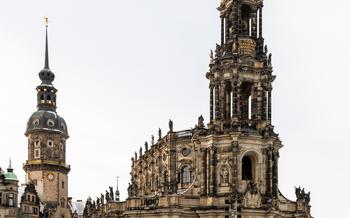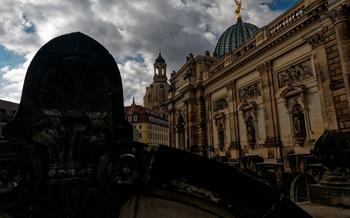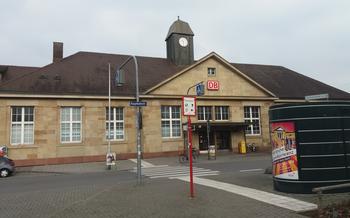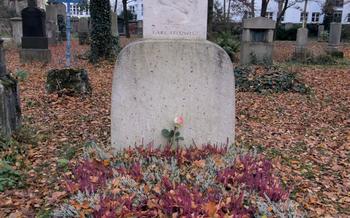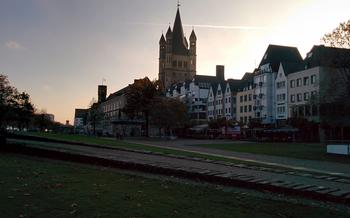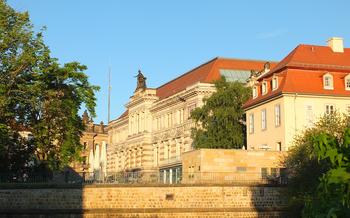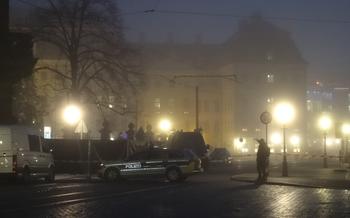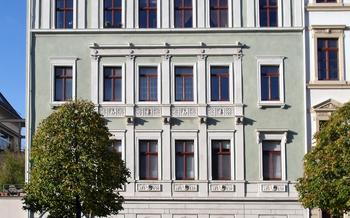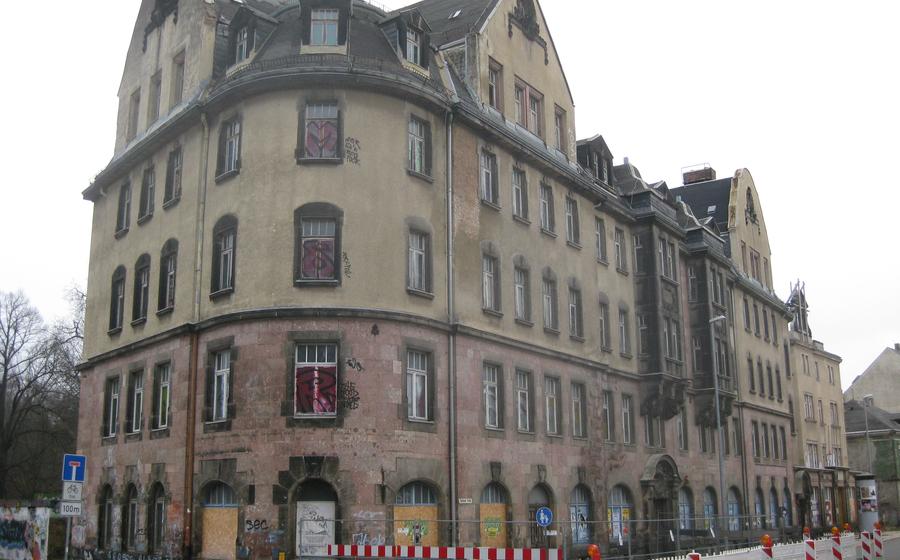
Volkshaus
- The History of the Volkshaus
- Exploring the Architecture
- A Culinary Destination
- Events and Entertainment
- Urban Renewal and Preservation
- Exhibitions and Displays
- Guided Tours
- Accessibility and Facilities
- Local Legends and Folklore
- Behind the Scenes
- Future Plans and Projects
- Practical Information
- Insider tip: Discover hidden treasures in the basement
The History of the Volkshaus
The Volkshaus in Chemnitz, Germany, stands as a testament to the city's rich history and architectural heritage. Constructed in 1906, this impressive building was initially designed by the renowned German architect Heinrich Straumer in the Art Nouveau style, a movement characterized by its intricate ornamentation and flowing lines. Originally conceived as a venue for social gatherings and workers' meetings, the Volkshaus has undergone several transformations over the years, reflecting the changing political and cultural landscape of Chemnitz. During the Nazi era, it was repurposed as a military headquarters, and in the post-war period, it served as a cultural center and a meeting place for the Socialist Unity Party (SED). After the reunification of Germany in 1990, the Volkshaus underwent extensive renovations, restoring it to its former glory and establishing it as a prominent landmark in the city. Today, it stands as a vibrant cultural hub, hosting a diverse range of events and exhibitions that celebrate Chemnitz's unique history and cultural identity.
Exploring the Architecture
The Volkshaus in Chemnitz stands out for its unique architectural features that blend historical and modern elements. Its exterior façade is adorned with intricate carvings and sculptures, paying homage to the building's rich past. Visitors are immediately drawn to the grand entrance, featuring a majestic archway supported by towering columns. The building's exterior also showcases a harmonious blend of red brick and white sandstone, creating a striking visual contrast.
Inside, the Volkshaus boasts a grand hall that serves as a breathtaking centerpiece. The hall's soaring ceiling is adorned with stunning stained glass windows, casting a kaleidoscope of colors onto the polished wooden floor. These windows depict scenes from German history and mythology, adding a touch of grandeur and cultural significance to the space. The hall's walls are adorned with intricate murals and paintings, further enhancing its visual appeal.
The Volkshaus's architecture is not merely decorative but also symbolic. The building's design incorporates elements from different architectural styles, reflecting the city's diverse history and cultural influences. The combination of Gothic, Renaissance, and Art Nouveau elements creates a unique aesthetic that sets the Volkshaus apart from other buildings in Chemnitz.
A Culinary Destination
The Volkshaus is renowned for its culinary offerings, attracting food enthusiasts from near and far. The building's grand restaurant, with its elegant ambiance and attentive service, has a rich history dating back to the early 20th century. It has long been a beloved destination for locals and visitors alike, offering a taste of Chemnitz's culinary heritage.
The restaurant's menu features a delectable array of dishes, showcasing the region's finest ingredients and traditional recipes. From hearty Saxon specialties to innovative contemporary creations, there's something to satisfy every palate. The restaurant's signature dish, "Sauerbraten," is a must-try for meat lovers, featuring tender venison marinated in red wine and spices, served with red cabbage and potato dumplings.
Over the years, the Volkshaus restaurant has hosted countless memorable events, from intimate gatherings to lavish banquets. It has been the setting for wedding receptions, birthday celebrations, and corporate functions, each leaving its mark on the building's history. The restaurant's reputation for excellence has been built on the dedication and passion of its talented chefs, who have crafted culinary delights that have delighted generations of diners.
One such chef, Herr Schmidt, who worked at the Volkshaus for over three decades, was known for his culinary artistry and his unwavering commitment to quality. His signature dish, "Himmel und Erde," a hearty combination of mashed potatoes, apples, and black pudding, became a beloved favorite among the locals. Herr Schmidt's legacy lives on in the restaurant's kitchen, where his recipes continue to be cherished and passed down to new generations of chefs.
Events and Entertainment
The Volkshaus has long been a hub for cultural activities and entertainment in Chemnitz, hosting a diverse range of events throughout the year. From intimate concerts to grand exhibitions and lively festivals, the building's unique ambiance and versatile spaces provide a captivating backdrop for a variety of events.
One of the highlights of the Volkshaus's event calendar is the annual Chemnitz Art Festival, which showcases the works of local and international artists in a vibrant celebration of creativity. The festival transforms the building into a living gallery, with paintings, sculptures, and installations adorning every corner. Visitors can admire the diverse range of artistic expressions, attend workshops, and engage with the artists themselves, creating a truly immersive and interactive experience.
Music lovers are also in for a treat at the Volkshaus, as the venue regularly hosts concerts featuring both established and up-and-coming artists. The grand hall, with its exceptional acoustics and ornate ceiling frescoes, provides an unforgettable setting for musical performances. From classical recitals to jazz concerts and rock shows, the Volkshaus offers a platform for a wide spectrum of musical genres, catering to diverse tastes and preferences.
In addition to concerts and exhibitions, the Volkshaus also plays host to a variety of festivals and cultural events throughout the year. The Chemnitz International Film Festival, for example, screens a selection of independent and foreign films, offering movie enthusiasts the chance to discover new cinematic voices and perspectives. The Volkshaus also hosts regular theater productions, dance performances, and literary readings, providing a platform for local and regional artists to showcase their talents.
Attending an event at the Volkshaus is not just about the entertainment itself; it's about immersing oneself in the building's rich history and vibrant atmosphere. The combination of stunning architecture, cultural offerings, and a sense of community makes the Volkshaus a truly special place to experience the arts and connect with fellow enthusiasts.
Urban Renewal and Preservation
The Volkshaus has played a pivotal role in Chemnitz's urban renewal efforts, embodying the city's dedication to preserving its historical heritage while embracing contemporary development. In the aftermath of World War II, the building suffered significant damage, and its eventual restoration became a symbol of the city's resilience.
Preserving the Volkshaus's historical integrity presented numerous challenges. The building's intricate facade required meticulous restoration, and experts worked tirelessly to maintain its original character. Balancing the need for modernization with respect for the building's heritage proved to be a delicate task.
Despite the challenges, the restoration process was a resounding success. The Volkshaus emerged as a vibrant cultural hub, attracting visitors from near and far. Its revival became a testament to the power of collaboration between architects, historians, and the local community.
Individuals like architect Hans-Jürgen Müller played a crucial role in the restoration. His dedication to preserving the building's original features while incorporating modern elements earned him widespread recognition. His work on the Volkshaus exemplifies the delicate balance between heritage preservation and urban development.
The Volkshaus stands as a testament to the transformative power of urban renewal. Its successful restoration has breathed new life into Chemnitz, demonstrating the harmonious coexistence of historical landmarks and contemporary architecture. It serves as an inspiration to other cities seeking to revitalize their urban landscapes while preserving their cultural heritage.
Exhibitions and Displays
The Volkshaus serves as a platform for showcasing Chemnitz's rich history and artistic heritage through its diverse exhibitions and displays. Permanent exhibits delve into the building's own history, tracing its evolution from a trade union center to a renowned cultural landmark. Visitors can immerse themselves in the stories of the people who shaped the Volkshaus, from its visionary architects to the passionate individuals who brought it back to life.
Temporary exhibitions rotate throughout the year, highlighting the works of local artists, exploring historical themes, and showcasing unique artifacts from Chemnitz's past. These exhibitions offer a dynamic and ever-changing cultural landscape, inviting visitors to discover new perspectives and engage with the city's vibrant creative community.
The Volkshaus's exhibitions are not merely displays of history and art; they are immersive experiences that transport visitors to different eras and worlds. Through interactive elements, multimedia presentations, and guided tours, the exhibitions bring the past to life and foster a deeper understanding of Chemnitz's cultural identity.
Guided Tours
For those who want to delve deeper into the history and significance of the Volkshaus, guided tours are available to provide a comprehensive and informative experience. Led by knowledgeable guides, these tours offer visitors an insider's perspective on the building's architecture, key events, and cultural impact.
During the tour, visitors will learn about the Volkshaus's origins as a symbol of workers' unity and its transformation into a cultural and entertainment hub. They will explore the grand hall, marvel at the intricate stained glass windows, and discover the hidden stories behind the building's unique features.
The guides will also share anecdotes about famous personalities who have graced the Volkshaus's stage, from renowned musicians and artists to political figures. Visitors will gain insights into the building's role in shaping Chemnitz's cultural identity and its enduring legacy as a cherished landmark.
To book a guided tour, visitors can contact the Volkshaus directly or check their website for available dates and times. It is advisable to book in advance, especially for groups or during peak tourist season, to avoid disappointment.
Whether you are a history buff, an architecture enthusiast, or simply someone who appreciates the beauty and grandeur of historic buildings, a guided tour of the Volkshaus is an unforgettable experience that will leave you with a deeper understanding and appreciation for this architectural gem.
Accessibility and Facilities
The Volkshaus is committed to providing an accessible and welcoming environment for all visitors, regardless of their abilities or needs. The building features wheelchair ramps and elevators, ensuring that all areas are easily accessible to those with mobility impairments. For those with visual impairments, audio guides and Braille signage are available upon request.
The Volkshaus also offers a range of amenities and services to enhance the visitor experience. Visitors can enjoy a delicious meal at the renowned restaurant, which offers a variety of local and international dishes. The building also houses a cozy café, perfect for grabbing a quick bite or a refreshing beverage. For those in need of a break, there are comfortable seating areas throughout the Volkshaus, where they can relax and soak in the historic ambiance.
To ensure a hassle-free visit, the Volkshaus provides ample parking spaces for visitors arriving by car. The building is conveniently located in the heart of Chemnitz, making it easily accessible by public transportation as well. For those driving, detailed directions and parking information can be found on the Volkshaus website.
Local Legends and Folklore
The Volkshaus is steeped in local legends and folklore, adding an air of mystery and enchantment to its already rich history. One enduring tale speaks of a hidden treasure buried beneath the building's foundation, believed to be the lost fortune of a wealthy merchant who frequented the establishment in its early days. Despite numerous attempts to locate the treasure, it remains undiscovered, fueling the imaginations of treasure hunters and locals alike.
Another legend revolves around a phantom opera singer who is said to haunt the grand hall, her ethereal voice echoing through the empty corridors when the building is quiet. According to the story, the singer met a tragic end within the Volkshaus walls, and her spirit remains attached to the place where she once performed. Visitors who claim to have heard her haunting melodies often leave with a sense of awe and wonder.
These stories and legends add a touch of magic and intrigue to the Volkshaus, making it not just a historical landmark but also a place where the past and the present intertwine in a captivating tapestry of myth and reality.
Behind the Scenes
The Volkshaus is not just a historical landmark; it is also a living, breathing institution that requires a dedicated team of individuals to keep it running smoothly. Behind the scenes, a host of passionate and hardworking professionals play crucial roles in maintaining the building's pristine condition, ensuring its efficient operations, and creating memorable experiences for visitors.
From the custodians who meticulously clean and maintain the grand halls and intricate stained-glass windows to the chefs who craft culinary masterpieces in the renowned restaurant, each member of the Volkshaus team plays a vital role in preserving its legacy. The technical crew works tirelessly behind the scenes to ensure that events run seamlessly, while the administrative staff handles everything from bookings and reservations to marketing and promotions.
Working at the Volkshaus is not just a job; it is a labor of love for many of these individuals. They take pride in being part of a team that keeps this iconic building alive and vibrant. Their dedication and passion are evident in every aspect of the Volkshaus experience, from the warm welcome visitors receive to the exceptional service they enjoy throughout their visit.
Future Plans and Projects
The Volkshaus is a dynamic and ever-evolving institution, with ongoing restoration and preservation efforts ensuring its continued vitality. The building's management team is dedicated to maintaining the historical integrity of the Volkshaus while embracing modern amenities and technologies to enhance the visitor experience.
Plans are underway for a range of future events and initiatives that will further showcase the Volkshaus's versatility and importance to the cultural landscape of Chemnitz. These include art exhibitions, concerts, theater productions, and community gatherings. The Volkshaus is also exploring collaborations with local schools and universities to create educational programs and workshops that delve into the building's history, architecture, and cultural significance.
One exciting project in the pipeline is the digitization of the Volkshaus's archives. This initiative will make a wealth of historical documents, photographs, and audio-visual materials accessible to researchers, students, and the general public. The digitized archives will provide valuable insights into the Volkshaus's past and its role in shaping the social and cultural fabric of Chemnitz.
The Volkshaus's future is bright, with a dedicated team committed to preserving its legacy while embracing innovation. Visitors can look forward to new and exciting experiences as the Volkshaus continues to evolve and adapt to the changing needs of its community.
Practical Information
Hours of Operation and Admission Fees
The Volkshaus is open to the public daily from 10 am to 6 pm. Guided tours are available upon request and must be booked in advance. Admission to the building is free, but some events and exhibitions may have a separate entrance fee. It is advisable to check the Volkshaus website or contact the information desk for the most up-to-date information on hours, fees, and scheduled events.
Contact Information and Website
For further inquiries or to book a guided tour, please contact the Volkshaus information desk at (+49) 371 1234567 or send an email to [email protected]. The Volkshaus also has a comprehensive website (www.volkshaus-chemnitz.de) where visitors can find detailed information about the building's history, upcoming events, and practical details.
Tips for Planning a Visit
To make the most of your visit to the Volkshaus, consider the following tips:
- Plan your visit around a specific event or exhibition to enhance your experience.
- Allow ample time to explore the building's exterior and interior, as there is much to see and appreciate.
- Take advantage of the guided tours to gain insights into the Volkshaus's history, architecture, and significance.
- If you are interested in dining at the Volkshaus restaurant, make a reservation in advance to avoid disappointment.
- Combine your visit with a stroll through the Chemnitz city center, where you can discover other historical landmarks and cultural attractions.
Insider tip: Discover hidden treasures in the basement
Venture into the basement of the Volkshaus to uncover a hidden gem – a charming, atmospheric tavern known as the "Kellerwirtschaft." This cozy space, with its vaulted ceilings and warm ambiance, offers a unique glimpse into the building's rich history. Indulge in a refreshing beverage and soak up the authentic atmosphere as you imagine the lively gatherings and conversations that have taken place here over the years. The tavern is a beloved spot for locals and visitors alike, offering a taste of Chemnitz's vibrant past in a truly unforgettable setting.
